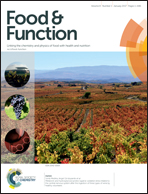Upregulation of caveolin-1 by mulberry leaf extract and its major components, chlorogenic acid derivatives, attenuates alcoholic steatohepatitis via inhibition of oxidative stress
Abstract
Excessive alcohol uptake exerts hepatocellular toxicity, ultimately leading to multiple liver diseases such as steatohepatitis and liver cirrhosis. Here, we aimed to explore the effects of mulberry leaf extract (MLE) and its major components chlorogenic acid (CGA) and neochlorogenic acid (nCGA) on alcoholic steatohepatitis. We determined the composition of MLE using liquid chromatography-mass spectrometric (LC-MS) analysis, which showed that MLE consisted of mainly chlorogenic acid derivatives and other polyphenols. Next, we utilized a high alcohol-fed mouse model and demonstrated that MLE alleviated alcohol-induced hepatocellular disorders, resulting in lowered hepatic injury markers and lipid accumulation. In addition, MLE reduced lipid peroxidation and meanwhile elevated hepatic superoxide dismutase (SOD). Immunohistochemical (IHC) staining revealed that MLE elevated the expression of caveolin-1 but reduced the expressions of epidermal growth factor receptor (EGFR), signal transducer and activator of transcription (STAT), inducible nitric oxide synthase (iNOS) and receptor interacting protein (RIP) 1/3. Major components of MLE, CGA and nCGA, not only exerted a similar biological activity as MLE but also inhibited alcohol-induced pro-apoptotic signals. Involvement of caveolin-1 in MLE, CGA and nCGA was demonstrated by using specific small inhibitory RNA. In conclusion, MLE and its chlorogenic derivatives CGA and nCGA upregulate caveolin-1 expression and diminish EGFR/STAT3/iNOS signalling, which may contribute to lowered hepatic lipid accumulation and peroxidation and inhibited pro-apoptotic cascades.



 Please wait while we load your content...
Please wait while we load your content...